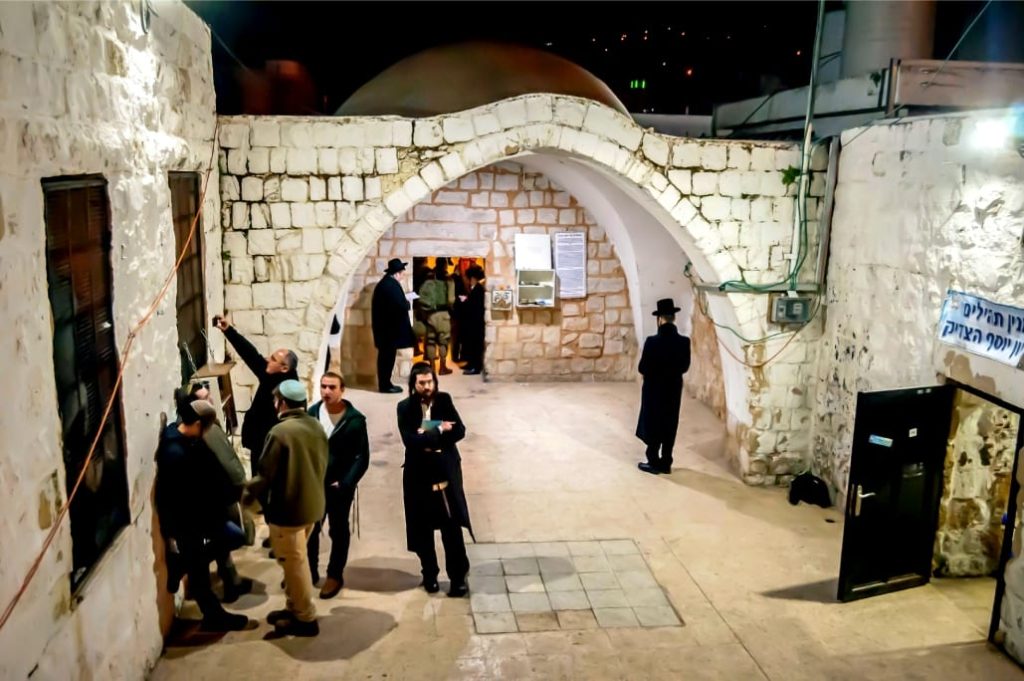Joseph’s Tomb is a funerary monument located at the eastern entrance to the valley that separates Mounts Gerizim and Ebal; not so far from Jacob’s Well, on the outskirts of the West Bank city of Nablus. It has been venerated throughout the ages by Samaritans, for whom it is the second holiest site, by Jews, by Christians, and by Muslims, some of whom view it as the location of a local medieval sheik Yusef Al-Dwaik.
The site is near Tell Balata, the site of Shakmu in the Late Bronze Age and later biblical Shechem. One biblical tradition identifies the general area of Shechem as the resting-place of the biblical patriarch Joseph and his two sons Ephraim and Manasseh. Multiple locations over the years have been viewed as the legendary burial place of Joseph. Post-biblical records regarding the location of Joseph’s Tomb somewhere around this area date from the beginning of the 4th-century CE. The present structure, a small rectangular room with a cenotaph, dates from 1868, and is devoid of any trace of ancient building materials.
What Does Archaeology Has to Say About Joseph’s Tomb
There is no archaeological evidence establishing the tomb as Joseph’s, and modern scholarship has yet to determine whether or not the present cenotaph is to be identified with the ancient biblical gravesite. The lack of Jewish or Christian sources prior to the 5th century that mention the tomb indicates that prior to the 4th century it was a Samaritan site. Samaritan sources tell of struggles between Samaritans and Christians who wished to remove Joseph’s bones.
The Biblical Narrative
According to the Bible, Joseph’s tomb stood on a plot of land purchased by Jacob from the sons of Hamor the father of Shechem when Jacob returned to the land of Canaan from Paddan Aram. This plot is one of the three sites mentioned in the Bible explicitly that they were bought with full money (the other two are the Cave of the Patriarchs bought by Abraham from the Ephron the Hittite, and Mount Moriah bought by David from Araunah the Jebusite).
18 After Jacob came from Paddan Aram, he arrived safely at the city of Shechem in Canaan and camped within sight of the city. 19 For a hundred pieces of silver, he bought from the sons of Hamor, the father of Shechem, the plot of ground where he pitched his tent. 20 There he set up an altar and called it El Elohe Israel.
Genesis 33 (18-20).
Then Joseph died in Egypt, but before his death he ordered the raising of his bones to the land:
24 Then Joseph said to his brothers, “I am about to die. But God will surely come to your aid and take you up out of this land to the land he promised on oath to Abraham, Isaac and Jacob. ” 25 And Joseph made the Israelites swear an oath and said, “God will surely come to your aid, and then you must carry my bones up from this place.”
Genesis 50 (24-25).
Indeed, when the children of Israel came out of Egypt, they took with them the bones of Joseph:
19 Moses took the bones of Joseph with him because Joseph had made the Israelites swear an oath. He had said, “God will surely come to your aid, and then you must carry my bones up with you from this place.”
Exodus 13, 19.
After the conquest of the land by the children of Israel under the leadership of Joshua son of Nun, Joseph’s bones were buried in the plot of land purchased by Jacob:
32 And Joseph’s bones, which the Israelites had brought up from Egypt, were buried at Shechem in the tract of land that Jacob bought for a hundred pieces of silver from the sons of Hamor, the father of Shechem. This became the inheritance of Joseph’s descendants.
Joshua 24, 32.
Joseph’s Tomb in the New Testament
The New Testament indicates the location of the plot of land that Jacob bought near Jacob’s Well and the city of Sychar:
4 Now he had to go through Samaria. 5 So he came to a town in Samaria called Sychar, near the plot of ground Jacob had given to his son Joseph. 6 Jacob’s well was there, and Jesus, tired as he was from the journey, sat down by the well. It was about noon.
John 5 (4-6).
Later Identifications of the Joseph’s Tomb
The identification of the compound now known as Joseph’s Tomb since ancient times relies, among other things, on its proximity to the city of Nablus and on traditions dating back to the Byzantine period written by travelers. The “Pilgrim of Bordeaux”, an anonymous pilgrim from the city of Burdigala (now Bordeaux, France) Also known as the Itinerarium Burdigalense is the oldest known Christian itinerarium about the Land of Israel, who passed by in 333, wrote:
“At the bottom (Mount Gerizim), there is a place called sechim where Joseph’s tomb is located in the plot of land that his father Jacob bequeathed to him.”
Itinerarium Burdigalense
Furthermore, Joseph’s tomb is mentioned in the Onomasticon – a list of names of places with biblical connection – by Eusebius of Caesarea from the 4th century:
“The city of Jacob, today is destroyed, and the place is shown in the suburbs of Neopolis, where Joseph’s tomb is also seen.”
Eusebius of Caesarea, Onomasticon
The Christian pilgrim Theodosius, who visited the Land of Israel at the beginning of the 6th century, also wrote:
“Near the well of Jacob are the bones of St. Joseph”.
Pilgrim Theodosius, De situ terrae sanctae
The Madaba Map depicts Joseph’s tomb east of Nablus








